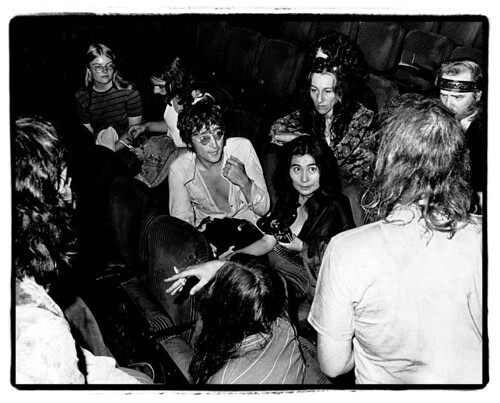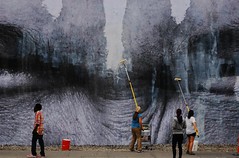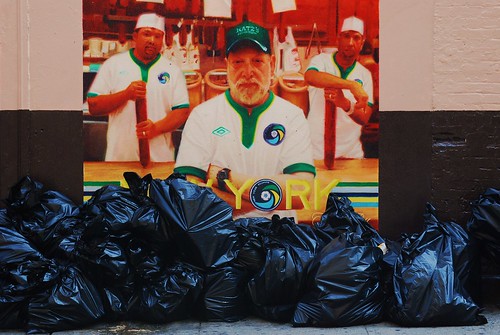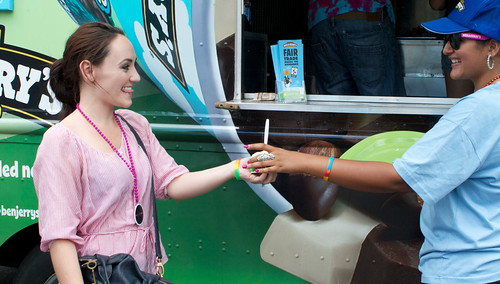 Khristopher J. Brooks Ben & Jerry’s employee Bernice Wooden hands out a scoop of Maple Blondie
Khristopher J. Brooks Ben & Jerry’s employee Bernice Wooden hands out a scoop of Maple BlondieFor days I had been trying to track it down — a large truck with Ben & Jerry’s employees passing out free ice cream. It had been driving around Manhattan aimlessly since June 16 and would leave July 29. I was determined to find it.
I don’t eat most sweets and desserts. Pies, cakes, doughnuts and candy bars taste like a mound of sugar when they hit my tongue. But I fold for Ben & Jerry’s ice cream, especially Strawberry Cheesecake and Willie Nelson’s Country Peach Cobbler.
And so, I went looking around Manhattan for this truck, hoping that the Ben & Jerry’s crew would give me a scoop.
But there was a problem. The truck was part of a special promotion designed to expose New Yorkers to the company’s newer flavors. The truck had no pre-determined stops; it spent most of its time going wherever New Yorkers tweeted for it to be. Taking the subway to catch the truck would have been a sucker’s game.
After some strategic phone calls and e-mails, I caught up with the truck at Pride Fest.
Read more…
Adrian Fussell, Vivienne Gucwa, Heather Holland, Susan Keyloun, Tim Schreier and Guney South — all members of The Local East Village Flickr Group — share their images of the weekend’s Gay Pride Parade and the celebrations surrounding the passage of the Marriage Equality Act.
Created with Admarket’s flickrSLiDR.
If you’d like a chance to see your best shots appear on The Local, join The Local East Village Flickr Group.
 Vivienne Gucwa
Vivienne GucwaGood morning, East Village.
We begin today with a reflection on the weekend, which many people spent celebrating the passage of same-sex marriage act late Friday and the Gay Pride Parade Sunday. You can find complete coverage in The Times, including a piece about the reaction a bit west of our neighborhood. And later this morning, we’ll present images of the parade and other celebrations in a slideshow of images shared by the members of The Local’s Flickr group.
In other neighborhood news, you might have to find a new place to buy your steaks. Many people were saddened Saturday to hear that the popular Jeffrey’s Meat Market was no longer in business on the Lower East Side. The Wall Street Journal reported that the meat market is believed to be one of the oldest in the neighborhood’s history; the former owner, Jeffrey Ruhalter, 55, represents the fourth generation of his family to work at the shop.
There’s also a new crime alert: the authorities are looking for “gentlemanly mugger” who robbed a 73-year-old woman near Union Square last week. DNAinfo reports that this mugger politely opened the door to Apple Bank on Wednesday night, watched the victim withdraw $200 then snatched it from her hand. The police said the suspect was wearing a camouflage hat, white tank top and jeans and a yellow rope as a belt.
Finally, the Rent Guidelines Board returns to Cooper Union’s Great Hall today to determine if, or by how much, they will raise rent prices in the East Village and throughout the city. The Local has reported on the rally and final public hearing session last week, and one tenant advocacy group will hold one more rally today. The Local will have a reporter at the meeting. Check back throughout the day for updates.
Earlier today, we wrote about the Fillmore East, one of the more remarkable properties within the confines of a proposed landmark district. The unofficial house photographer of the Fillmore East, Amalie R. Rothschild, shared her photos and memories from the theater’s brief yet influential existence from 1968 to 1971. — Stephen Rex Brown
Read more…
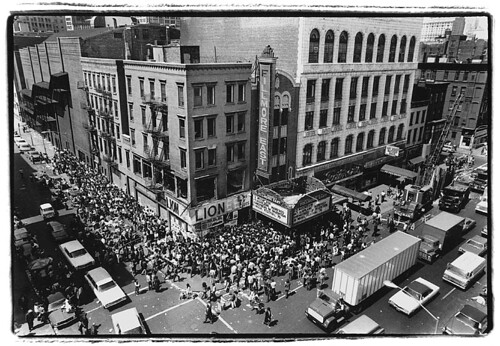 Amalie R. Rothschild A huge crowd formed around the Fillmore East in May 1970 when tickets went on sale for Crosby, Stills, Nash and Young.
Amalie R. Rothschild A huge crowd formed around the Fillmore East in May 1970 when tickets went on sale for Crosby, Stills, Nash and Young.The push to preserve blocks of the neighborhood through a landmark district has, not surprisingly, led to a lot of conversations about the history of the area. The proposed district covers roughly six blocks, and perhaps no property within the tract has hosted more important figures in American culture than the former Fillmore East building at 105 Second Avenue.
Now, the entrance to the building is an Emigrant Savings Bank, and the 2,600-seat theater has been replaced with an apartment building. But the Fillmore’s three-year existence had a lasting impact culturally; Jimi Hendrix, Joe Cocker and Miles Davis all recorded well-regarded live albums there. The Who played their rock opera, “Tommy” in its entirety for the first time in the United States in 1969 at the Fillmore East. And the first rock concert to be broadcast on television was taped there in 1970.
But the Fillmore’s impact went beyond the performers onstage. Numerous technological innovations during the theater’s short existence were adopted at concert venues across the country.
“I was blown away by what a creative, experimental theater environment there was at the Fillmore East,” said Amalie R. Rothschild, a photographer who was among the many NYU students who landed dream jobs at the Fillmore when it opened in 1968. “It was a real place to do real things. The students had a live laboratory within which to work.”
Read more…
As the humidity broke on Wednesday around 7 p.m., umbrellas hid the growing line outside of Other Music, the record shop on East Fourth Street. The rainfall cooled the crowd, but it was no match for the utter coldness these show-goers were waiting for: a live performance from the much-hyped Danish punk band Iceage. Watch a clip of their set — dark, piercing, and endearingly sloppy — above.
It was Iceage’s third New York set, following their sold out, stateside debut on Friday at Williamsburg’s Northside Festival. The teenage quartet — fronted by Elias Bender Ronnenfelt, 19 — plays the DIY venue 285 Kent in Williamsburg on Saturday with other bands, including Jeff the Brotherhood. Iceage’s debut LP, “New Brigade,” is out now.
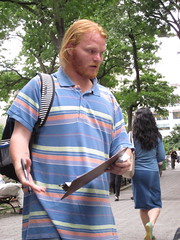 Meghan Keneally Chris Coon.
Meghan Keneally Chris Coon.Chris Coon takes a very methodical and well-accounted approach to panhandling, not because he is particularly fond of organization, but because he thinks of his work on the sociological level.
Mr. Coon, 29, is conducting a “social experiment” by trying to see how long it will take him to ask one million people for a donation to help get him out of homelessness.
In order to preserve the integrity of the project, he has a number of rules that he follows: he doesn’t start making the rounds until about 1 p.m. because he doesn’t like to talk to people while they’re eating (“its not respectful,” he said). He tries to remember the faces of the people he talks to because he doesn’t want to count them twice. He prefers to talk to couples, because it counts as two people. And more than anything, he hates it when people cut him off mid-spiel because then it doesn’t count at all.
To Mr. Coon, it all comes down to the numbers, and since starting in the beginning of May, the big number is the 3,462 people he has asked.
“I think it’s intuitive and creative and I made it into a job instead of just going up and saying ‘Hey, look, can I have a dollar?’” he said. “I probably have to speak to five or six million people to be able to actually ask one million of them.”
When he approaches people in Union Square, which has been his base of operations and his home on and off for the past few years, Mr. Coon explains the concept of his “experiment” and then records their gender and ethnicity, in an attempt to make the project as professional and accurate as possible.
“I want this to feel as much as an experiment as it can because for me it is an experiment to see how quickly I get out of being homeless,” Mr. Coon said.
Read more…
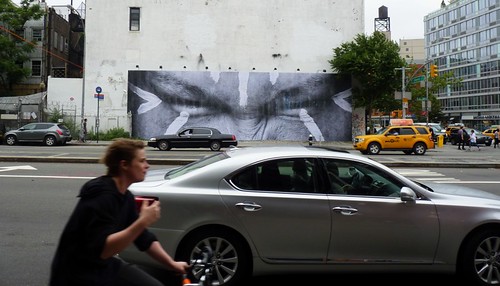 Michael Natale
Michael Natale 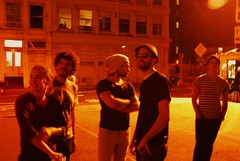 Tim Schreier
Tim SchreierGood morning, East Village.
Another major overhaul took place Thursday at the corner of Bowery and East Houston. A new face, pictured above, has replaced the colorful ghouls painted by artist Kenny Scharf on the Tony Goldman graffiti wall; EV Grieve says it’s called, “Lakota, North Dakota.” Community contributor Tim Schreier shared photos of the work in progress at right.
Local theatergoers will have their last chance to visit Performance Space 122 this Saturday before the venue on the corner of First Avenue and Ninth Street temporarily closes for renovations. Theater Mania reports that the organization — named for the old Public School 122 building it has inhabited since 1979 — will relocate until construction is complete.
Counter will also soon be gone. The vegetarian bar and bistro on First Avenue between Sixth and Seventh Streets told Gothamist that its closing is imminent, although owner Deborah Gavito has yet to give an exact date.
 Khristopher J. Brooks
Khristopher J. Brooks A tiny crowd of photographers and birdwatchers has gathered outside NYU’s Bobst Library trying to spot Pip, the red-tailed hawk who flew for the first time earlier today. Many in the the crowd of onlookers were excited that the 49-day-old hawk made a successful take off, but were bewildered about where she went during the flight. Visit The City Room blog of The Times for more updates.
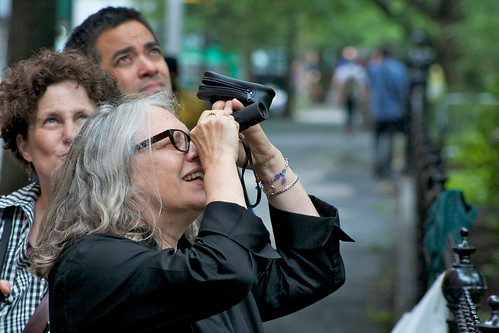 Khristopher J. Brooks Ann Green, who lives in Washington Square Village, looks at Pip’s parents, Bobby and Violet (top photo) through binoculars.
Khristopher J. Brooks Ann Green, who lives in Washington Square Village, looks at Pip’s parents, Bobby and Violet (top photo) through binoculars.
 Courtesy of Lizzy Plapinger Lizzy Plapinger and Derek Davies.
Courtesy of Lizzy Plapinger Lizzy Plapinger and Derek Davies.Instead of trying to break into the music industry with new technology, one record company is looking back to the technology of the past to introduce new acts.
Lizzy Plapinger and Derek Davies started producing limited edition 7-inch vinyl singles for new and emerging bands through their record label, Neon Gold. Since starting in August 2008, when the now-23 year olds were only juniors in college, they have been credited for much of the early success of a number of indie bands and recently partnered with Columbia Records.
Ms. Plapinger and Mr. Davies are childhood friends, having spent summers together at camp in Martha’s Vineyard, Mass. When summers came to a close, they returned to school in London and Washington, D.C. respectively but kept in touch about new music.
“It was always a pipe dream,” Ms. Plapinger said of their early talks about starting a record label together.
Though they had both held internships in the music industry and searched for new talent out of habit, they decided to start their specialized company in 2008 even though they were in the middle of college.
“We couldn’t really let this opportunity pass us by,” Mr. Davies said.
Read more…
 Stephen Rex Brown A new gallery exhibit by Jesper Haynes chronicles 20 years of living in the East Village.
Stephen Rex Brown A new gallery exhibit by Jesper Haynes chronicles 20 years of living in the East Village.Plenty of longtime locals love talking about the good old days in the East Village, but Jesper Haynes can point to his photography as proof of what a great time he had in the neighborhood.
“St. Marks: 1986-2006” is an exhibition of Mr. Haynes’ photographs taken inside his two-and-a-half bedroom apartment at the corner of First Avenue and St. Marks Place that is opening this evening at Gallery Onetwentyeight on the Lower East Side. A diverse group of close friends, pretty girls and kooky characters are shot in various states of undress, intoxication, and exuberance.
Read more…
 Todd Olmstead Some of the selection at Van Daag.
Todd Olmstead Some of the selection at Van Daag.For many coffee drinkers, the morning brew is a ritual, an essential start to the day whether consumed at home, work, or somewhere in between. But for coffee geeks, the experience is so much more than adding fuel. It’s a precise, scientific process in which beans cultivated with care on small farms in far away countries are ground specifically for that single, perfect cup. Many are coming to drink coffee with the same attention as fine wine.
Joining the movement is Van Daag, with a new coffee menu featuring beans from two renowned Scandinavian micro-roasters.
“Van Daag wanted a coffee program that would be something different, something that New York hadn’t seen yet,” David Latourell of Intelligentsia Coffee & Tea told me. He helped assemble Coffee Collective of Copenhagen and Tim Wendelboe of Oslo along with Ecco Caffe, a small California roastery that Intelligentsia owns.
One patron described the former World Barista Champion as “godlike,” but Mr. Wendelboe, who is tall and has boyish features, doesn’t carry himself like a star. This event felt more like a gathering of old friends – though they were also happy to dispense their considerable coffee wisdom to anyone eager to slurp the brown nectar.
Read more…
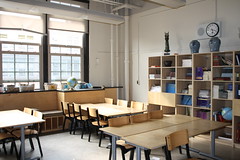 Laura E. Lee An empty classroom at Ross Global Academy.
Laura E. Lee An empty classroom at Ross Global Academy.With the end of the school year just around the corner, students at Ross Global Academy are eagerly awaiting the start of summer. But some families face uncertain futures when the academy permanently closes its doors at the end of the month.
The New York City Department of Education announced the closure the charter school on East 11th Street at First Avenue in December, citing the reports of the school’s low test scores and high teacher turnover.
With the announcement, parents and staff fought to keep the school open. The school’s founder, multimillionaire Courtney Sale Ross, sent a letter to the Department of Education asserting that the Department did not follow proper procedures and requesting a renewal. Chancellor Joel Klein denied the request.
Richard Burke, executive director of the school, said that the Department has promised to place everyone by the end of the month. But some parents, still bitter about the circumstances of the closure, are angry about the reassignment process.
“We’re displaced,” said Noemi Hernandez, president of the academy’s Parent-Teacher Association. Ms. Hernandez said that although she lives in the neighborhood, she cannot register her two children at local schools without Department of Education approval.
Read more…
A video feature produced by students for The Village Beat.
We’d like to welcome a new blog to the neighborhood, The Village Beat, which features the work of undergraduate students from across the country in The Hyperlocal Newsroom Summer Academy at NYU Journalism.
Yvonne Latty of NYU’s Arthur L. Carter Journalism Institute teaches one of the hyperlocal classes — and said that the site was created as a showcase for student work.
“We’re sending out these cub reporters and watching them grow,” she said. “They’re out on the streets, knocking on people’s doors, shooting video, taking photos — they’re hustling; we’re pushing them to be published. What you’re seeing is the future, and we’re planting the seeds.”
Other NYU Journalism professors involved in the project include Betty Ming Liu and Adrian Mihai, who designed the blog.
Be sure to check out their stories throughout the summer, and follow their Tweets, too.
 Michelle Rick
Michelle Rick Good morning, East Village.
When you think all the good ones are taken, try looking in your own backyard. That’s right East Villagers, our neighborhood ranks as the number one place for dating in New York City — or at least according to the online dating site, HowAboutWe. The Village Voice reported the findings earlier this week, noting that Webster Hall and the Strand top the list of local hotspots.
Of course there are other reasons for coming to the East Village, as we’ve seen each year with the so-called Crusties; but now it seems some of these annual squatters are not getting a warm welcome from the authorities, according to Andrea Stella, executive director of The Space at Tompkins.
But that’s not all that’s changing this summer. Jeremiah’s Vanishing New York shares photos from East Villager Andrea Legge, who lives in the building next to Mars Bar; both buildings will be bulldozed by the end of August.
Earlier today, EV Grieve reported on the closure of Open Road Park. We now have more details about what led to the closure. The park was closed by officials at East Side Community High School; principal Mark Federman cited an increase in drinking, smoking, fighting, littering and vandalism on the premises as the reasons for the closure. The school will hold a public meeting next week to discuss how to improve conditions at the park — in the meantime, children will have to look for another spot to skate and shoot some hoops.
—Chelsia Rose Marcius
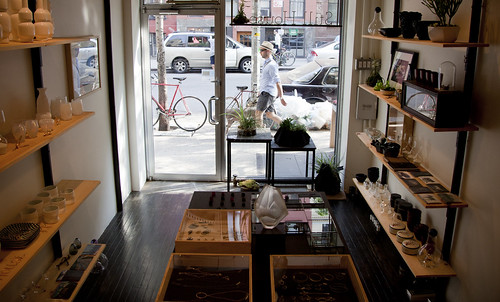 Joshua Davis East Village boutiques have thrived by offering low priced merchandise to its customers. Still House, 117 East Seventh Street, sells artwork and jewelry by local artists.
Joshua Davis East Village boutiques have thrived by offering low priced merchandise to its customers. Still House, 117 East Seventh Street, sells artwork and jewelry by local artists.With reports of hard times for struggling Lower East Side boutiques, The Local paid a visit to merchants on East Seventh Street to see how their businesses are faring. But rather than echoing the frustrated voices of Lower East Side merchants, many of whom have closed or moved to Brooklyn, the East Village is holding steady and even opening new stores.
The secret: low prices.
Here is what some local shopkeepers had to say about starting up and surviving in the East Village.
Rena Reborn and Still House, both at 117 East Seventh Street
Two newcomers to the block, both stores opened within a week of another last month, and both specialize in selling goods from local artists and designers. Rena Reborn, which sells new and recycled jewelry and clothing for women, draws many of its customers with $5 and $10 racks.
“Low prices keep us in business,” says owner Rachael Rush.
Read more…
 Ian Duncan Owner Sam Penix makes a coffee at Everyman Espresso. Customers now swipe their credit cards through an iPad to pay
Ian Duncan Owner Sam Penix makes a coffee at Everyman Espresso. Customers now swipe their credit cards through an iPad to payWhen web designer Matt Norris wants a coffee at Everyman Espresso, he doesn’t reach to his pocket for cash or a credit card. With a quick few swipes on his iPhone and a look at the barista he has paid and his drink is on its way to being made. For the barista’s part, he just looks Mr. Norris in the face, confirms his identity and the transaction is complete.
Everyman, on East 13th Street, is an early adopter of Square, a mobile-based payment system developed by Twitter founder Jack Dorsey. The company’s name derives from the little square card reader that connects to a merchant’s (or anyone’s, for that matter) iPhone or iPad, turning it into a payment device, an approach a number of other companies are also taking. In May, Square launched its new product, the card case, which stores regular customers’ details and allows for flesh payments like that made by Mr. Norris for his coffee.
Following in the footsteps of a reporter from Fast Company, I tried out Square at Everyman, opting for the more conventional method of swiping my card. It works pretty much as you might expect: run the card through the white plastic reader, which connects to the iPad’s headphone jack, and sign using the touch screen and a finger. That last part was a little awkward – the result was a childlike scrawl that only loosely approximated my signature, but it was apparently sufficient for my bank.
Read more…





